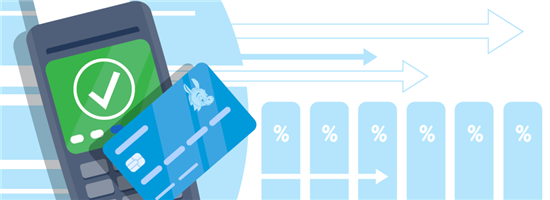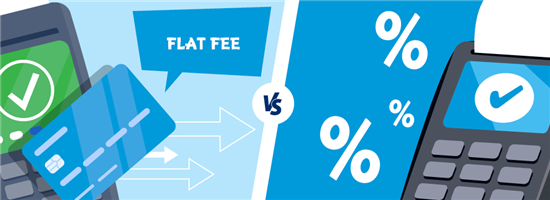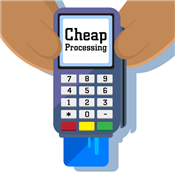Flat Fee Credit Card Processing
Flat-fee credit card processing can be affordable, depending on your business. Read on for the ins and outs of this pricing model.
 |
Flat-fee credit card processing is more suitable for new, small, or seasonal businesses. It can get really expensive for large and established ones, especially with millions of sales per year.
This is because your sales volume, accepted payment methods, and average ticket size will determine how much it will affect your bottom line.
This article should help you decide if a flat rate is a good idea. Plus, you get to compare other pricing models with it, so you can decide the best option for your business.
What is Flat-Fee Credit Card Processing?
 |
Flat-fee credit card processing involves flat rates as your credit card transaction fees. For example, Square charges 2.6% + $0.10 per transaction for in-person card payments.
It's a pricing model structured as a fixed percentage + fixed fee per transaction regardless of card type. The rates just differ based on how the transaction was made (i.e., in person, online, keyed-in).
Flat rates are predictable, so you can better budget for your processing costs using your average sales volume.
This pricing model is cheapest for businesses with low transaction volumes. But as your business grows, it's better to switch to interchange-plus pricing or subscription pricing to make credit card processing more cost-effective.
Some flat-rate credit card processors offer free plans. If they offer paid plans, you may be offered discounted flat rates for higher tiers.
Flat-fee credit card processing is built a little different from other pricing models. Here's how it works.
How Does Flat-Fee Credit Card Processing Work?
Let's say your customer makes an in-person card payment of $100. And your processor of choice charges 2.6% + 10¢ for card-present transactions. For this transaction, your processing fee is $2.7.
How is this different than other pricing models? It's important to grasp the 3 parts of a credit card processing fee.
- Interchange fees
These are paid to the banks that issue the credit cards. - Assessment fees
Assessment fees are paid to the credit card networks, like Visa, Mastercard, American Express, and Discover. - Processor markup
These are fees charged by your payment processing company.
With flat-rate credit card processing, the interchange and markup fees are blended together. This makes it less transparent since you don't know how much you're specifically paying for either.
That said, this makes it simpler to budget for, too, because all card brands are typically charged the same rate.
This isn't the case for credit card processing companies offering interchange-plus pricing or subscription pricing. These two factor in direct-cost interchange which vary per card brand.
Average Flat-Fee Credit Card Processing Rates
The average credit card processing fee ranges from 1.5% to 3.5%. But flat rates can range from 2.6% to 3.5% plus $0.10 to $0.30. This varies whether the customer paid in person, online, or through a keyed-in payment.
How do you know if flat-fee processing is worth it?
Is Flat-Fee Processing a Good Idea?
Flat-fee credit card processing can be a good idea for new and small businesses. Especially if the processor offers a free plan and pay-as-you-go pricing.
As a new business, you may have sporadic sales, and so this can be more cost-effective for you. Other pricing models are more suited for mid-sized to larger businesses.
That said, you can consider these factors in your decision:
- Transaction Volume
Consider how many transactions your business processes on a monthly basis. If you have a high sales volume, interchange-plus pricing might be more cost-effective.
- Average Transaction Amount
If your average transaction amount is low, flat-fee processing may be more suitable. However, if your transactions are generally higher in value, interchange-plus pricing could be more beneficial.
For instance, a $20 purchase charged a 2.6% + $0.10 per transaction will cost you $0.62. While a $100 purchase charged at the same rate will cost you $2.7.
- Flexibility and Customization
Determine whether or not you need the ability to negotiate rates or take advantage of specific card brand promotions. Flat-fee processing may have limitations in this area.
- Accepted Mode of Payment
Flat rates are the cheapest if you accept in-person payments. But if you mainly take payments over the phone, it can be a really expensive option.
When is flat-fee credit card processing an expensive option?
Flat rates can be expensive if you have large sales volumes and high ticket sizes.
As a simplified example, let's say your business has an average order value of $100, and you're earning $20,000 monthly. That's an average of 200 transactions in a month.
If the processor charges 2.6% to 3.5% + $0.10 to $0.15 per transaction, that will cost you about $7,620 per year.
Examples of Flat-Fee Credit Card Processors
Learning about some of the flat-fee credit card processors may further help you decide and understand if this pricing model is the best for your business.
Square
| In-person transactions | 2.6% + $0.10 per transaction |
|---|---|
| Online transactions | 2.9% + $0.30 per transaction |
| Keyed-in transactions | 3.5% + $0.15 per transaction |
Square is a flat-rate payment processor with a full suite of POS systems. You can choose from a variety of hardware options, plus you can pick a plan suitable for your business industry. You can get a free account and a free card reader to start.
Square Reader: Free Mobile Credit Card Reader
- Pay 2.6% + 10¢ Per Swipe for Visa, Mastercard, Discover, and American Express
- Accept Credit Cards Anywhere
- Fast Setup, No Commitments
Stripe
| In-person transactions | 2.7% + $0.05 per transaction |
|---|---|
| Online transactions | 2.9% + $0.30 per transaction |
| Keyed-in transactions | 3.4% + 30¢ per transaction |
Stripe is another flat-rate processor, but it's more suitable for online businesses. You can maximize the platform if you have on-staff developers due to all the coding/customizations you can do.
Like Square, you have no monthly fees with your account.
Online Payment Processing
- Accept payments worldwide and automate payouts and financial workflows seamlessly
- Grow with confidence: Whether you're running an e-commerce store, subscription service, or marketplace, Stripe adapts to any business model
- Trusted by millions: From startups to Fortune 500 companies, Stripe powers businesses of every size
- Predictable costs: Transparent flat-rate pricing with no setup fees or monthly charges – pay only for what you use
- Enable more sales: Support credit cards, mobile wallets, and 135+ international payment methods
- Developer-friendly tools: Integrate payments quickly with Stripe's intuitive APIs and documentation
Chase Payment Solutions
| In-person transactions | 2.6% rate +10¢ per tap, dip and swiped transaction |
|---|---|
| Online transactions | 2.90% + 25¢ per eCommerce transaction and monthly fee starting at $9.95 |
| Keyed-in transactions | 3.5% rate +10¢ per keyed transaction |
Unlike Square and Stripe, Chase is a merchant account provider. This means you'll be required to undergo an underwriting process to open an account.
Chase Payment Solutions may be more suitable for Chase Business Banking customers due to the perks they can get. But growing companies and mobile businesses may also do well with it.
Chase Payment Solutions℠
- Limited time offer: Get $100 off the Chase Point of Sale (POS)℠ Terminal. Fill out the form and ask a Payments Advisor how to claim.
- Fast funding at no additional cost. Get deposits as soon as same day.
- Get fair and transparent pricing with no hidden fees. 2.6% rate +10¢ per tap, dip and swiped transaction. 2.90% + 25¢ per eCommerce transaction and monthly fee starting at $9.95. 3.5% rate +10¢ per keyed transaction.
- Get paid fast and manage your business from anywhere with the Chase Point of Sale system. Use our mobile app, reader and terminal to take payments via tap, dip and swipe.
- Process payments with Chase Payment Solutions, the #1 merchant acquirer in the U.S.
- Tap to Pay on iPhone offers you the ability to accept contactless cards, Apple Pay and other digital wallets on your iPhone – no additional hardware required.
- Chase Customer Insights is a complimentary business intelligence platform that offers simple, actionable analytics and reports to help you make better business decisions and reach more customers.
National Processing
| In-person transactions | 2.5% + $0.10 per transaction (Basic In-person Package), 2.41% + $0.10 per transaction (Advanced Package) |
|---|---|
| Online transactions | 2.9% + $0.30 per transaction |
| Keyed-in transactions | 3.5% + $0.15 per transaction |
National Processing is another merchant account provider offering flat-rate pricing. However, you will be charged monthly fees starting at $9.95/mo.
Since National Processing offers low in-person transaction rates, it can be more suitable for businesses with physical locations. It even beats the in-person rates of Square, Stripe, and Chase.
Now that you know how flat rates work and some of its examples, here's how it compares to other pricing models.
Flat Fee vs. Other Pricing Models
 |
There are three more pricing models apart from flat-rates. They could be more cost-effective depending on your business.
Flat Fee vs. Interchange-Plus Pricing
Interchange-plus pricing is typically more affordable than flat-rate pricing. Interchange rates tend to be cheaper than flat rates set by credit card processing companies.
Interchange rates typically range from 1.6% to 2.4% for credit cards and 0.5% for debit cards. This is also why it may be more suitable for high-volume businesses.
In addition, interchange-plus pricing is more transparent than flat-rate pricing. You'll know exactly how much you're paying for interchange rates, card brand fees, and processor markup.
Take a look at Helcim's pricing below as an example. Helcim is a merchant account provider offering interchange-plus pricing.[1]
| Monthly Volume | In-person Transactions | Online and Keyed Transactions |
|---|---|---|
| $0 - $50,000 | Interchange + 0.40% + 8¢ | Interchange + 0.50% + 25¢ |
| $50,001 - $100,000 | Interchange + 0.35% + 7¢ | Interchange + 0.45% + 20¢ |
| $100,001 - $500,000 | Interchange + 0.25% + 7¢ | Interchange + 0.35% + 20¢ |
| $500,001 - $1,000,000 | Interchange + 0.20% + 6¢ | Interchange + 0.25% + 15¢ |
| $1,000,001+ | Interchange + 0.15% + 6¢ | Interchange + 0.15% + 15¢ |
Start Accepting Payments Fast
- Interchange Plus Pricing
- No Monthly Fees
- No Contracts
Flat Fee vs. Tiered Pricing
Tiered pricing is similar to flat rate pricing. But instead of one flat rate, you get 3.
Depending on the type of card used, you may be charged a qualified rate, a mid-qualified rate, or a non-qualified rate.
- Qualified Rates
Qualified rates are specific to debit cards and non-rewards cards. It's the lowest possible rate charged by a payment processor for processing a credit or debit card transaction.
That said, it's reserved for transactions that meet certain criteria, such as:
- Payments processed within a certain timeframe
- Swiped payments instead of manually entered
- Payments that meet other requirements set by the processor
Ensure that your transactions meet the payment processor's criteria to help you save money on processing fees. - Payments processed within a certain timeframe
- Mid-qualified Rates
Mid-qualified rates apply to standard rewards cards, like loyalty and cashback reward cards. Keyed-in payments and transactions not processed within 24 hours may also be considered.
They typically fall in the middle of the spectrum when it comes to interest rates and other fees associated with credit cards.
- Non-qualified Rates
Non-qualified rates apply to premium cards, corporate cards, international cards, card-not-present transactions, and transactions with missing information.
These rates are typically the highest among the three.
Flat Fee vs. Subscription Pricing
If a processor offers subscription pricing or membership pricing, then you'll need to pay a monthly fee for your account. Often, you'll get little to no processor markup. But you'll still pay the direct interchange cost.
This pricing model may be most cost-efficient for large businesses since you won't be charged large percentage rates. Stax is an example of a payment processor offering subscription pricing.
Save Up to 40%
- Flat Monthly Subscription Price, Starting at $99
- 0% Markup on Direct-Cost Interchange
- 24/7 Support
Flat Fee vs. Zero-Fee Processing
Zero-fee processing or no-fee credit card processing lets you surcharge your customers. And to surcharge your customers means to pass on the credit card fees to them.
It's typically a set percentage by your payment processor. This can help you save on processing fees. However, only credit card payments can be surcharged.
Note that your customers may not be so stoked about being charged additional fees for their purchase.
Free Credit Card Processing with Surcharging
- You keep 100% of every credit card sale: when you sell $100, you receive $100. Pay only for debit card transactions.
- Fully Compliant
- CardX passes on the fee for credit card transactions only. Your customers can always choose debit as a no-fee option.
You can pass credit card fees to your customers through surcharges in most states. There are payment processors that specialize in no-fee credit card processing, like Helcim. That said, be sure you're fully aware of the rules of surcharging before you start.
Advantages and Disadvantages of Flat-Fee Credit Card Processing
 |
Compared to other pricing models, there are a couple of reasons why you may (or may not) opt for flat-rate pricing.
Advantages
- Provides transparency and predictability in pricing
- Simplifies budgeting and makes it easier to calculate your processing costs
- Cost-efficient if it comes with a free account
- Don't need to worry about non-qualified rates for premium cards (all transactions are charged the same flat rate)
Disadvantages
- Not for businesses with high average transaction amounts or large sales volumes
- May not offer the same level of flexibility and customization as other pricing models
- Offer less transparency with your processing cost (you won't know how much you're paying for interchange fees, assessment fees, and processor markup)
There is no universal answer when figuring out the cheapest way to take card payments. But generally, in-person payments are cheaper to process than online and manually entered payments.
Regarding pricing models, small businesses may save on monthly fees with some flat-rate processors offering free plans. High-volume businesses may save more with interchange-plus pricing.
What If Flat-Fee Credit Card Processing Isn't Suitable for Your Business?
If flat-fee credit card processing isn't suitable for your business, there are alternative pricing models you can explore.
- Interchange-plus pricing can be better for quickly-growing businesses.
- Tiered pricing can work for businesses with brick-and-mortar stores.
- Subscription pricing is most suited for large-volume businesses or enterprises.
How to Save Money on Processing Fees
Apart from selecting the right payment processing company based on pricing model, here are a few more things you can do to save money from processing card payments:
- Cut down on credit card fraud
Whenever a customer disputes a charge, you're slapped with a chargeback fee that can range from $15 - $50 (plus loss of the sale). One fraud dispute can easily cost your business twice the sales amount.
Plus, if you have a lot of fraud, you can be labeled a "high risk" merchant. Which means higher processing rates.
To prevent fraud, you can verify your customer's identity with photo ID, use AVS, ask for the CVV security code, and maintain PCI compliance.
What is AVS (Address Verification System)
An address verification system (AVS) verifies that the billing address entered matches the address on file on the cardholder account. If they don't match, then the transaction is declined. - Avoid manual entry
Manually keyed-in transactions have the highest processing rates. If you're taking cards in person, avoid manual entry as much as possible. If the card won't swipe, ask if the customer has another payment method instead.
- Negotiate with the payment processing company
The interchange rates charged by the credit card networks are not negotiable. BUT you can negotiate anything the provider has control over.
Some of these include the processor's markup, annual or monthly fees, payment gateway fees, etc.
The key to negotiating is to be a valuable client. The more sales you have, the more negotiation power you possess. If your business has grown from when you first signed up, it's a good time for a chat. - Choose higher-tiered or customizable plans
Payment processors typically offer lower transaction fees for higher-tiered plans. You may also get a customized plan with affordable rates if you meet the minimum sales volume requirements.
- Encourage debit card payments
Debit cards have much lower interchange fees because of the lower risk of fraud. The typical interchange rate for debit cards is just 0.5%, while credit cards are around 1.6% to 2.4%.
- Pass the fee to your customers
If you REALLY want to avoid processing fees, you can offset them through surcharging. Though we don't fully recommend it. And it's not even legal in all states.
If this is something you want to consider, you should be familiar with the rules.
- Set up cash discounting
As the name suggests, you can provide discounts to customers who pay with cash to encourage this mode of payment. This means your posted prices will be the prices which include credit card transaction fees.
- Charge convenience fees
Convenience fees are fees you charge customers for modes of payment you don't typically accept. Let's say you typically accept cash payments, you can charge customers a convenience fee if they prefer to pay with a credit card.
Just be sure to note the card brand rules for them.
Bottom Line
In conclusion, flat-fee credit card processing offers simplicity and predictability for businesses. With a flat-fee structure, you can easily calculate your costs and avoid surprises.
However, it's important to consider if this pricing model aligns with the specific needs of your business. Factors such as transaction volume and average ticket size should be taken into account.
References
Write to Karen Eloriaga at feedback@creditdonkey.com. Follow us on Twitter and Facebook for our latest posts.
Note: This website is made possible through financial relationships with some of the products and services mentioned on this site. We may receive compensation if you shop through links in our content. You do not have to use our links, but you help support CreditDonkey if you do.
Not sure what is right for your business?
|
|
|
Answer a few short questions in our credit card processing quiz to receive tailored recommendations to help you keep more profits.
|
|
| ||||||
|
|
|














